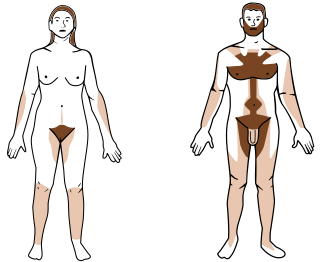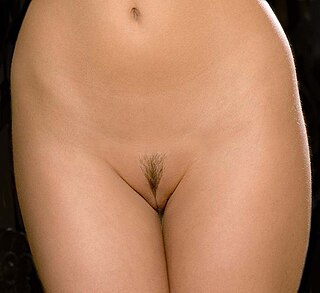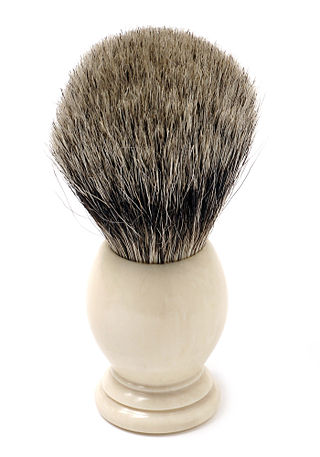
A barber is a person whose occupation is mainly to cut, dress, groom, style and shave men's and boys' hair or beards. A barber's place of work is known as a barbershop or the barber's. Barbershops have been noted places of social interaction and public discourse since at least classical antiquity. In some instances, barbershops were also public forums. They were the locations of open debates, voicing public concerns, and engaging citizens in discussions about contemporary issues.

Pubic hair is terminal body hair that is found in the genital area of adolescent and adult humans. The hair is located on and around the sex organs and sometimes at the top of the inside of the thighs. In the pubic region around the pubis bone, it is known as a pubic patch. Pubic hair is also found on the scrotum and base of the penile shaft in the male and on the vulva in the female.

Hair removal, also known as epilation or depilation, is the deliberate removal of body hair or head hair.

Shaving is the removal of hair, by using a razor or any other kind of bladed implement, to slice it down—to the level of the skin or otherwise. Shaving is most commonly practiced by men to remove their facial hair and by women to remove their leg and underarm hair. A man is called clean-shaven if he has had his beard entirely removed.

Waxing is the process of hair removal from the root by using a covering of a sticky substance, such as wax, to adhere to body hair, and then removing this covering and pulling out the hair from the follicle. New hair will not grow back in the previously waxed area for four to six weeks, although some people will start to see regrowth in only a week due to some of their hair being on a different human hair growth cycle. Almost any area of the body can be waxed, including eyebrows, face, pubic hair, legs, arms, back, abdomen, chest, knuckles, and feet. There are many types of waxing suitable for removing unwanted hair.

An eyebrow is an area of short hairs above each eye that follows the shape of the lower margin of the brow ridges of some mammals. In humans, eyebrows serve two main functions: first, communication through facial expression, and second, prevention of sweat, water, and other debris from falling down into the eye socket. It is common for people to modify their eyebrows by means of hair removal and makeup.

Bikini waxing is the removal of pubic hair using a special wax, which can be hot or cold, that adheres to hairs and pulls them out when the wax is removed quickly from the skin, usually with a cloth strip. While the practice is mainly associated with women, male waxing is sometimes done to remove men's pubic hair.

A razor is a bladed tool primarily used in the removal of body hair through the act of shaving. Kinds of razors include straight razors, safety razors, disposable razors, and electric razors.
Underarm hair, also known as axillary hair or armpit hair, is the hair in the underarm area (axilla).

Pseudofolliculitis barbae (PFB) is a type of irritant folliculitis that commonly affects men who have curly or coarse facial hair. It occurs when hair curls back into the skin after shaving, causing inflammation, redness, and bumps. This can lead to ingrown hairs, scarring, and skin discoloration. PFB can be treated with various methods, including changing shaving habits, using topical creams or ointments, and undergoing laser hair removal. Prevention measures include proper shaving techniques, using sharp razors, and avoiding too close a shave.
Sugaring, sugar waxing, or Persian waxing is a method of hair removal that has been in use since 1900 BC. Historically, sugar was confined to the regions surrounding Persia until the first millennium AD. As a result, it is speculated that honey was the first sugaring agent. Sugaring was also known as sukkar or ḥalawa in the Middle East, as ağda in Turkey, and as moum in Iran.

A hair clipper, often individually called the apparent plurale tantumhair clippers, is a specialised tool used to cut human head hair. Hair clippers work on the same principle as scissors, but are distinct from scissors themselves and razors. Similar but heavier-duty implements are used to shear sheep, but are called handpieces or machine shears.

A shaving brush or shave brush is a small brush with a handle parallel to the bristles used to make lather from shaving soap or shaving cream and apply it to the face when shaving. Shave brushes are often decorative; antique handles are often made from materials such as ivory or even gold, though the bristle load may be composed of any number of natural or synthetic materials. The shave brush is used most often today by "wet shavers" in tandem with a single- or double-edged safety razor or a straight razor. However, this is not always the case, as shavers of all varieties may employ the tool.

Ingrown hair is a condition where a hair curls back or grows sideways into the skin. The condition is most prevalent among people who have coarse or curly hair. It may or may not be accompanied by an infection of the hair follicle (folliculitis) or "razor bumps", which vary in size. While ingrown hair most commonly appears in areas where the skin is shaved or waxed, it can appear anywhere. Anything that causes the hair to be broken off unevenly with a sharp tip can cause ingrown hairs. Ingrown hairs are also caused because of lack of natural exfoliation in the skin.

Body hair, or androgenic hair, is terminal hair that develops on the human body during and after puberty. It is different from head hair and also from less visible vellus hair, which is much finer and lighter in colour. Growth of androgenic hair is related to the level of androgens and the density of androgen receptors in the dermal papillae. Both must reach a threshold for the proliferation of hair follicle cells.

Judaism prohibits shaving with a razor on the basis of a rabbinic interpretation of Leviticus 19:27, which states, "Ye shall not round the corners of your heads, neither shalt thou mar the corners of thy beard." The Mishnah interprets this as a prohibition on using a razor on the beard.
Body grooming is the act of maintaining a clean appearance. It is typically associated with hair.

Irritant folliculitis is an inflammation of the hair follicle. It characteristically presents with small red bumps in the skin at sites of occlusion, pressure, friction, or hair removal; typically around the beard area in males, pubic area and lower legs of females, or generally the inner thighs and bottom. An associated itch may or may not be present. Pseudofolliculitis barbae is a type of irritant folliculitis in the beard area.
At the outset of the United States, leg and underarm hair removal was not a common practice for women. In fact, body hair had been viewed as a boon by Caucasian people, and therefore removal was not an imported practice from European settlers into the United States. The removal of armpit and leg hair by American women became a new practice in the early 20th century due to a confluence of multiple factors.












